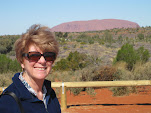The photos below are of an Iban graveyard. The old expression "you can't take it with you" is meaningless to the Iban. All the stuff on the top of the grave are the possessions of the recently departed. This cemetery was moderately recent. The graves of the oldest Iban people in the area got covered by the dam waters in the Batang Ai. This is a higher ground, newly improved cemetery.
Soli is seen walking toward the car in the photo below. The emphasis should be on the hill in the distance. It's covered with palm oil trees. This is one of the main farming goods that are done here. The locals used to burn some rain forest and then plant rice. With the palm oil, they can just plant the trees and not do burning. The palm oil fruits are on the ground in the next photo. Apparently, the seeds are edible, and the refuse from the oil crushing is used for fertilizer. All's well except the clogged vein bits.
We stopped at the side of the road to get photos of wild orchids and pitcher plants. A photographer (or two) are seen below.
A pitcher plant. The flower was about 3 inches long.
I can't remember the flower below, but the yellow and pink flowers grow on the same bush. The yellow are the female and the pink are the male. The leaves were used by the Malay as plates. According to Soli, when they used to finish eating they tossed their "plates". Unfortunately, now that they have plastic and paper, they still do the same thing.
We stopped at Luchuan on the way home for another tea. It was Saturday morning and the local market was open.
The Malay eat a lot of fish. Below are bags of salted, dried, and fresh fish for sale. There were dozens of stalls with these fish for sale.
After our tea, we stopped at a pepper plantation. The pepper here grows on vines, and the locals use poles (or smallish trees with straight trunks) to let the vines grow upward. Green pepper corns are juvenile pepper corns. Some turn red - hence red pepper - these are then sorted by hand, making the red pepper very expensive. Black pepper comes from the dried pepper berries. White pepper is when they take the pepper and soak it for a few days - the rind comes off - and voila - white pepper.
A pepper sorting machine is seen below. The good stuff (heavier) falls to the left, the lighter junk falls to the right.
We then had lunch in a lovely park with water falls, bridges, and a nice cafe. The leaves were so large on the plant below, I needed Charlie for scale.
Below is a jail - or was originally - now it's just cool looking.
A crocodile spout along the river.
A local fisherman fishing for catfish.
The Brooke boathouse and some skyline. A busy day, we ended by taking a river boat ride.
Lots of houses along our drive looked like the one below. Most were in fields near the jungle - this one had a river view.
The houses across the river were in the typical Malay style.
All in all a great day. We will miss Soli.























No comments:
Post a Comment